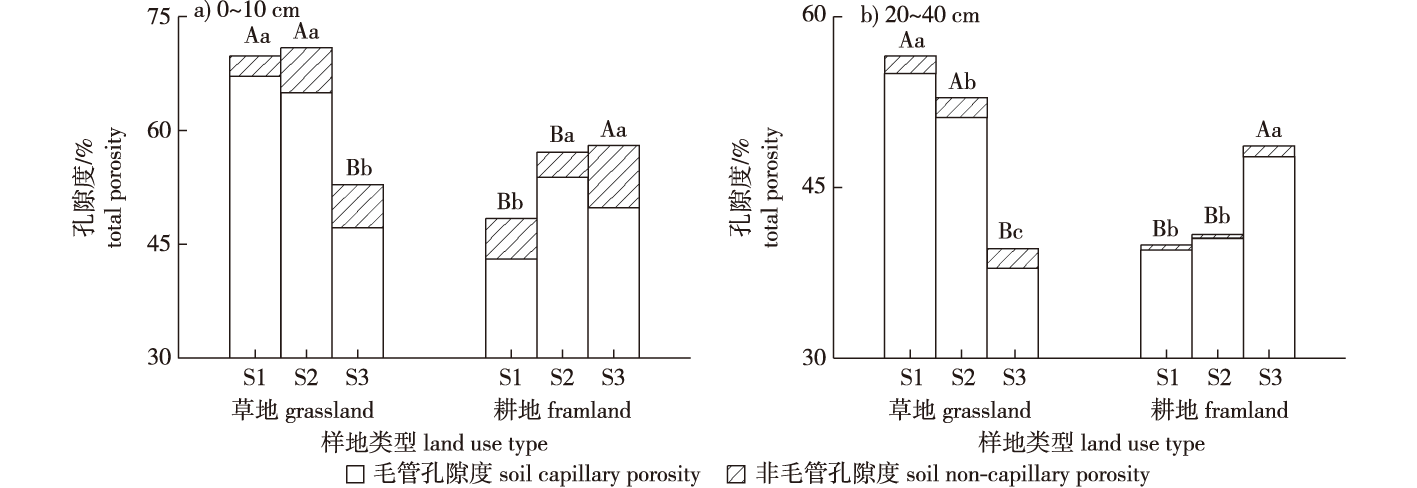 PDF(1520 KB)
PDF(1520 KB)


东北典型黑土区农田土壤结构变化区域特征分析
刘超南, 王恩姮, 陈祥伟, 王亚婷, 李锦诺
南京林业大学学报(自然科学版) ›› 2025, Vol. 49 ›› Issue (1) : 194-200.
 PDF(1520 KB)
PDF(1520 KB)
 PDF(1520 KB)
PDF(1520 KB)
东北典型黑土区农田土壤结构变化区域特征分析
Variation characteristics of soil structure in different farmlands across the typical black soil region in northeast China
【目的】探讨东北黑土区耕地结构性状的退化程度与区域差异,为不同区域黑土地保护与退化耕地修复提供参考。【方法】以东北典型黑土区3个区域(丘陵漫岗、漫川漫岗、低山丘陵)未开垦草地和开垦60 a耕地为研究对象,利用干湿筛法和环刀法测定了土壤团聚体特征、土壤孔隙与持水特征以及土壤三相(固液气)结构特征并进行对比分析。【结果】开垦前丘陵漫岗和漫川漫岗区土壤团聚体机械稳定性、土壤团聚体水稳性、土壤孔隙度和持水量显著高于低山丘陵区,而广义土壤结构指数(值越大越适宜作物生长)显著低于低山丘陵区。长期(60 a)耕作后,土壤团聚体机械稳定性退化不明显,而土壤团聚体水稳性退化程度表现为低山丘陵>丘陵漫岗>漫川漫岗;土壤孔隙度和持水能力在丘陵漫岗和漫川漫岗退化严重,而在低山丘陵地区反而增加。表层0~10 cm土层固液气三相比例在丘陵漫岗和漫川漫岗区更加趋近理想三相结构,但低山丘陵区无显著变化;在3个区域20~40 cm土层均因固相比例增加导致土壤三相结构显著退化。【结论】东北典型黑土区开垦前土壤结构存在区域差异,丘陵漫岗和漫川漫岗区的土壤团聚体结构、孔隙结构和持水能力较优,低山丘陵区的土壤三相结构较优。农田土壤结构整体呈退化趋势,但退化程度存在区域差异,丘陵漫岗和漫川漫岗区土壤孔隙结构和三相结构退化较为严重,低山丘陵区土壤团聚体结构退化较为严重。
【Objective】This study aims to explore the degradation degree and area differences of soil structure in different areas across the typical black soil region, and to provide reference and basis for the protection of black soil and the restoration of degraded cultivated land. 【Method】 The characteristics of soil aggregates, soil porosity and water retention capacity, and soil three-phase structure of uncultivated grassland and farmland (cultivated for 60 years) were measured by dry-wet sieving and cutting ring method, and were comparatively analyzed in three areas (hill area, rolling hill area, low mountain area). 【Result】The results showed that the mechanical and water stability of aggregates, porosity, and water retention quality of soil were significantly better in the uncultivated hill area and rolling hill area than those in the low mountain area, while the generalized soil structure index was significantly lower in the low mountain area. The degradation of the mechanical stability of aggregates was not obvious after long-term cultivation (60 years), while the degradation of water stability of aggregates was in the order of low mountain area > hill area > rolling hill area. The total porosity and water retention capacity of the soil in the hill area and rolling hill area degraded seriously, while it showed an increased tendency in the low mountain area. The ratio of solid, liquid and gas phases of soil approached the ideal three-phase structure and was beneficial to crop growth in the 0-10 cm soil depth of the hill area and rolling hill area, but there was no significant change in the low mountain area. The increase in the solid phase proportion leads to the obvious degradation of the soil three-phase structure in the 20-40 cm soil depth of all three areas. 【Conclusion】The soil structure in uncultivated areas has regional differences in the typical black soil region. The hill area and rolling hill area had a superior aggregate structure, soil pore structure, and water retention capability, while the low mountain area had a superior soil three-phase structure. Farmlands in the three different areas across the typical black soil region showed a trend of degradation, with varying degrees of degradation among the areas. The soil pore structure and the three-phase structure of the hill area and rolling hill area degraded more seriously, while the aggregate structure of the low mountain area degraded more seriously.

土壤结构 / 土壤团聚体 / 土壤孔隙 / 土壤持水性 / 土壤三相 / 东北典型黑土区
soil structure / soil aggregate / soil pore / water retention capability of soil / soil three-phase / typical black soil region in northeast China
| [1] |
汪景宽, 徐香茹, 裴久渤, 等. 东北黑土地区耕地质量现状与面临的机遇和挑战[J]. 土壤通报, 2021, 52(3):695-701.
|
| [2] |
陈学文, 张晓平, 梁爱珍, 等. 耕作方式对黑土耕层孔隙分布和水分特征的影响[J]. 干旱区资源与环境, 2012, 26(6):114-120.
|
| [3] |
|
| [4] |
张孝存, 郑粉莉, 王彬, 等. 不同开垦年限黑土区坡耕地土壤团聚体稳定性与有机质关系[J]. 陕西师范大学学报(自然科学版), 2011, 39(5):90-95.
|
| [5] |
谷思玉, 胡洋, 聂艳龙, 等. 农垦九三管理局不同开垦年限农田黑土团聚体变化[J]. 东北农业大学学报, 2015, 46(11):56-62.
|
| [6] |
宋秀丽, 谷思玉, 郭爱玲, 等. 九三农场不同开垦年限农田黑土养分分析[J]. 东北农业大学学报, 2010, 41(2):66-69.
|
| [7] |
周一杨, 王恩姮, 陈祥伟. 不同开垦年限黑土溅蚀与团聚体分选特征[J]. 应用生态学报, 2009, 20(10):2411-2416.
|
| [8] |
崔明, 张旭东, 蔡强国, 等. 东北典型黑土区气候、地貌演化与黑土发育关系[J]. 地理研究, 2008, 27(3):527-535.
|
| [9] |
崔明, 蔡强国, 范昊明. 东北黑土区土壤侵蚀研究进展[J]. 水土保持研究, 2007, 14(5):29-34.
|
| [10] |
邹文秀, 韩晓增, 严君, 等. 耕翻和秸秆还田深度对东北黑土物理性质的影响[J]. 农业工程学报, 2020, 36(15):9-18.
|
| [11] |
李万星, 李小霞, 李丹, 等. 不同轮作模式下旱地番茄土壤理化性质及细菌群落组成特征[J]. 江苏农业学报, 2022, 38(4) :949-957.
|
| [12] |
王秋菊, 高中超, 张劲松, 等. 黑土稻田连续深耕改善土壤理化性质提高水稻产量大田试验[J]. 农业工程学报, 2017, 33(9):126-132.
|
| [13] |
刘宝元, 张甘霖, 谢云, 等. 东北黑土区和东北典型黑土区的范围与划界[J]. 科学通报, 2021, 66(1):96-106.
|
| [14] |
史静静, 杨琳, 曾灿英, 等. 土壤制图中多目标属性的环境因子及其尺度选择:以黑龙江鹤山农场为例[J]. 地理研究, 2018, 37(3):635-646.
|
| [15] |
潘鹤, 周桐, 韩少杰, 等. 植被的人工恢复对典型黑土有机质组分影响的时效性[J]. 东北林业大学学报, 2022, 50(5):95-99.
|
| [16] |
赵斯, 赵雨森, 王林, 等. 东北黑土区农林复合土壤效应[J]. 东北林业大学学报, 2010, 38(5):68-70.
|
| [17] |
张琛, 赫有有, 薛婷婷, 等. 松嫩平原北部未开垦黑土土壤物理性状垂直变化特征[J]. 水土保持研究, 2023, 30(6):231-240.
|
| [18] |
赵友朋, 孟苗婧, 张金池, 等. 凤阳山主要林分类型土壤团聚体及其稳定性研究[J]. 南京林业大学学报(自然科学版), 2018, 42(5):84-90.
|
| [19] |
曹伟, 李露, 赵鹏志, 等. 坡地黑土碳氮分布及其与团聚体稳定性的关系[J]. 北京林业大学学报, 2018, 40(8):56-63.
|
| [20] |
|
| [21] |
|
| [22] |
苏永中, 王芳, 张智慧, 等. 河西走廊中段边缘绿洲农田土壤性状与团聚体特征[J]. 中国农业科学, 2007, 40(4):741-748.
|
| [23] |
林琳, 单博, 卢倩倩, 等. 模拟机械压实黑土持水特征与孔隙分布[J]. 东北林业大学学报, 2014, 42(12):102-105.
|
| [24] |
李辰, 陈颢明, 胡亦舒, 等. 富磷生物炭协助溶磷细菌对Cu的修复机制[J]. 生物加工过程, 2022, 20(6):658-664.
|
| [25] |
郑旭, 赵文静, 刘兴满, 等. 苏北滨海盐渍土土壤基本性质及其对中山杉生长的影响[J]. 江苏农业学报, 2023, 39(9):1854-1861.
|
| [26] |
李晓龙, 高聚林, 胡树平, 等. 不同深耕方式对土壤三相比及玉米根系构型的影响[J]. 干旱地区农业研究, 2015, 33(4):1-7,29.
|
/
| 〈 |
|
〉 |